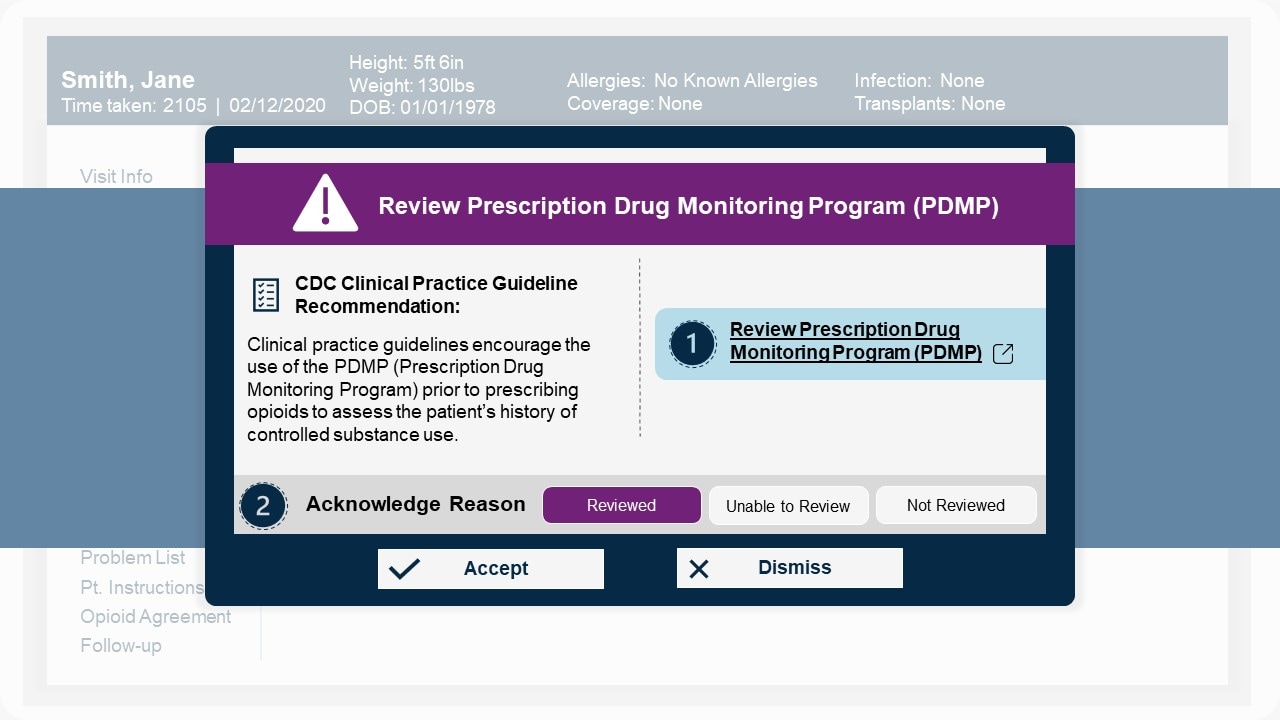Healthcare Executives

These tools are supported by most EHR vendors. Determine whether your EHR system can support these tools and check with your chief medical information officer about the level of effort required to support this investment.
Healthcare executives play a key role in implementing CDC’s Opioid Prescribing CDS tools in their health system to promote safer opioid prescribing for patients in the context of managing chronic pain.
These tools provide “just in time” information to help clinicians make decisions about patient care. With security parameters already built in to protect patient information, CDS tools improve efficiency, cost benefit, and clinician and patient satisfaction.1
“We already had an existing inpatient set of guidelines. With CDC, we built an outpatient set of guidelines focusing on primary care and practice [for our EHR].”
In the Clinical Setting
Enhancing traditional EHR CDS systems, the CDC opioid prescribing CDS tools reinforce quality measures for clinicians by providing prompts and visual cues in alignment with the 2016 CDC Guideline recommendations to promote patient safety. These measures include the need for prescribing naloxone, and the use of urine drug testing.
CDS prompts only appear for relevant patients and will not show up for all patients. For example, if a clinician misses a step when writing a patient’s prescription, such as forgetting to check the PDMP, a visual cue will appear, prompting the clinician to check the PDMP before proceeding with the prescription. Workflow integration is key to clinician adoption.

Naloxone Case Study—Duke Health
“As part of our pilot testing, we set up naloxone best practice advisories (BPAs) for ambulatory care. This was initially one of our best BPAs. We included pictures, bulleted educational information, and links to the 2016 CDC Guideline. Since clinicians are very busy, we included a brief explanation about why it is important to prescribe naloxone to this patient. After rollout, we saw an increase in naloxone prescriptions for patients.”
Supporting System-Wide Safer Opioid Prescribing
Keep the user interface clean with very direct and prescriptive information.
Consider including pictures, colored fonts, and/or visuals in the CDS prompts to grab the attention of clinicians.
These tools were tested and evaluated to ensure that the prompts are consistent with the intent of the underlying 2016 CDC Guideline recommendations. Technically and clinically evaluated in pilot testing, these tools offer health systems a pre-vetted approach to implementing the 2016 CDC Guideline. The CDS tools can be used in a variety of settings from small individual practices to large health systems’ EHRs.
These tools can help support health systems with safer opioid prescribing whether it is for a particular patient population or a component of a larger initiative. For example, Montefiore Medical Center executives incorporated the CDC CDS tools to align with ongoing efforts to standardize the delivery of judicious opioid prescribing for patients with chronic non-cancer pain. At Stormont Vail Health, executives integrated the CDC CDS tools as part of a system-wide long-term strategic plan to improve chronic pain management and opioid prescribing.
1Clinical Decision Support. HealthIT.gov. https://www.healthit.gov/topic/safety/clinical-decision-support
